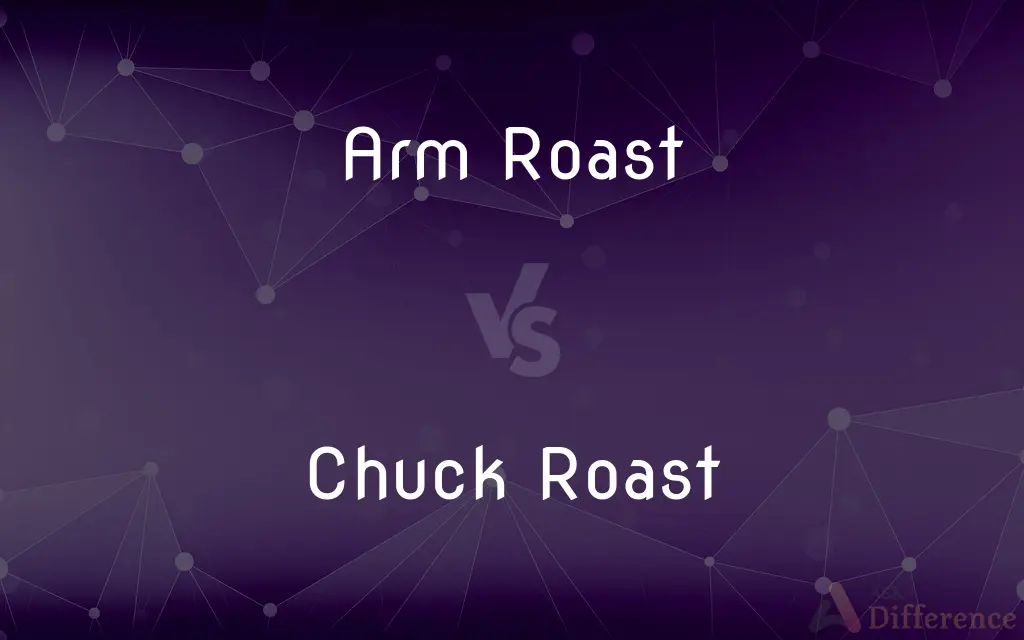Arm Roast vs. Chuck Roast — What's the Difference?
By Tayyaba Rehman & Maham Liaqat — Published on May 16, 2024
Arm Roast comes from the cow's shoulder, is leaner, and suits slow cooking, while Chuck Roast, also from the shoulder, has more fat, offering a richer flavor and tender texture when braised.

Difference Between Arm Roast and Chuck Roast
Table of Contents
ADVERTISEMENT
Key Differences
Arm Roast, sourced from the cow's upper shoulder (or arm section), is characterized by its lean meat and a small amount of marbling, making it ideal for slow-cooking methods to achieve tenderness. On the other hand, Chuck Roast comes from the lower neck and shoulder area, containing more fat and connective tissue, which, when cooked slowly, melts to create a moist, flavorful, and tender meat.
While Arm Roast is often considered a more economical cut due to its leaner composition, it requires careful preparation to ensure it doesn't become tough. Chuck Roast, with its higher fat content, is more forgiving during cooking, easily becoming tender and juicy, making it a preferred choice for braises and stews.
The cooking methods for Arm Roast typically involve braising or slow cooking in a liquid to tenderize the meat, making it perfect for dishes where it can absorb flavors from broths and sauces. Conversely, Chuck Roast is versatile, excelling in slow-cooked dishes but also capable of being roasted in an oven, where its fat content contributes to its succulence and flavor.
In terms of nutritional value, Arm Roast tends to have slightly less fat and fewer calories, making it a better option for those looking for a leaner protein source. Whereas Chuck Roast, due to its higher fat content, offers a richer flavor and a more calorie-dense option.
Despite these differences, both cuts are popular for their ability to become tender and flavorful through slow cooking, with the choice between them often coming down to personal preference for texture and fat content. Both Arm and Chuck Roasts serve as hearty, comforting meal options, especially in colder weather.
ADVERTISEMENT
Comparison Chart
Origin
Upper shoulder (arm section)
Lower neck and shoulder
Fat Content
Leaner, with minimal marbling
Higher fat content and connective tissue
Cooking Method
Best when braised or slow-cooked in liquid
Versatile: braised, stewed, or oven-roasted
Texture
Becomes tender when cooked properly
Naturally tender, becomes more so when slow-cooked
Ideal Use
Slow-cooked dishes, absorbing flavors well
Braises, stews, and roasts, offering rich flavor
Nutritional Value
Lower in fat and calories
Higher in fat, more calorie-dense
Cost
Often more economical due to leaner meat
Can be pricier due to high demand and fat content
Preparation Tips
Requires careful slow cooking to avoid toughness
Forgiving in cooking, easy to tenderize
Compare with Definitions
Arm Roast
Known for its minimal fat content, making it a healthier beef option.
We chose an arm roast for its lower calorie content.
Chuck Roast
High in fat, making it tender and juicy when braised.
The fat in the chuck roast melted, enriching the sauce with flavor.
Arm Roast
Often requires marination or slow braising to achieve tenderness.
We marinated the arm roast overnight before slow cooking it.
Chuck Roast
Popular for its rich flavor and tender texture in slow-cooked meals.
The chuck roast's rich flavor made it the star of the stew.
Arm Roast
Economical choice for beef dishes that benefit from long cooking times.
The arm roast offered a budget-friendly option for our weekend dinner.
Chuck Roast
Versatile in cooking methods, including braising and roasting.
We roasted the chuck roast in the oven for a succulent Sunday meal.
Arm Roast
Ideal for dishes that simmer for hours, absorbing the flavors of the liquid.
The arm roast absorbed the flavors of the wine and vegetables in the stew.
Chuck Roast
A flavorful, fatty beef cut from the lower neck and shoulder.
The chuck roast was cooked slowly until it fell apart with a fork.
Arm Roast
A lean cut of beef from the upper shoulder, suited for slow cooking.
The arm roast was slowly cooked with herbs until tender.
Chuck Roast
Slightly pricier due to its desirable fat content and tenderness.
The chuck roast was worth the extra cost for its superior flavor and texture.
Common Curiosities
What is the main difference between Arm Roast and Chuck Roast?
The main difference lies in their fat content and origin; Arm Roast is leaner and comes from the upper shoulder, while Chuck Roast is fattier and comes from the lower neck and shoulder.
Which cut is healthier, Arm Roast or Chuck Roast?
Arm Roast is leaner, making it a healthier option with fewer calories and less fat.
Can Arm Roast be used for stewing?
Yes, Arm Roast is excellent for stewing, especially when slow-cooked in a liquid.
Can the cooking method affect the texture of these roasts?
Absolutely, slow cooking or braising is essential for both cuts to achieve a tender texture.
What is the best way to cook a Chuck Roast to maximize tenderness?
Slow cooking or braising in liquid on low heat maximizes tenderness by melting the fat and connective tissue.
How does the fat content in these cuts affect their cooking?
Fat content affects flavor and tenderness; more fat in Chuck Roast means it's more flavorful and tender when cooked, whereas Arm Roast needs careful cooking to avoid toughness.
How should Arm Roast be prepared to ensure tenderness?
Arm Roast should be slow-cooked or braised in a liquid to ensure it becomes tender.
Why might someone choose an Arm Roast over a Chuck Roast?
They might prefer a leaner cut or seek a more economical option for slow-cooked dishes.
Can either of these roasts be cooked quickly?
These roasts are best cooked slowly; quick cooking methods may result in tough meat.
Is Chuck Roast good for slow cooking?
Yes, Chuck Roast is ideal for slow cooking, as its fat content renders down, making the meat tender and flavorful.
Can Chuck Roast be oven-roasted?
Yes, Chuck Roast can be oven-roasted, benefiting from its fat content, which keeps it moist and tender.
What makes Chuck Roast a popular choice for braises and stews?
Its higher fat content and connective tissue melt during slow cooking, enriching the dish with flavor and creating a tender texture.
Is Arm Roast more economical than Chuck Roast?
Generally, yes, Arm Roast can be more economical due to its leaner composition.
Share Your Discovery

Previous Comparison
Hair Stylist vs. Barber
Next Comparison
Solid State Physics vs. Condensed Matter PhysicsAuthor Spotlight
Written by
Tayyaba RehmanTayyaba Rehman is a distinguished writer, currently serving as a primary contributor to askdifference.com. As a researcher in semantics and etymology, Tayyaba's passion for the complexity of languages and their distinctions has found a perfect home on the platform. Tayyaba delves into the intricacies of language, distinguishing between commonly confused words and phrases, thereby providing clarity for readers worldwide.
Co-written by
Maham Liaqat














































